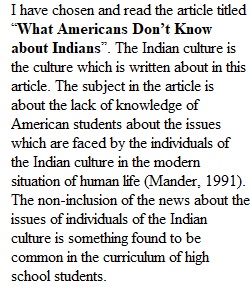


Q Instructions for the Article Essays Two essays will be given throughout the semester. For each essay you will choose and read one article located in Canvas folder corresponding to the week that the essay is due. Make sure you address each of the following points for each article you choose. 1) Describe the culture/subject written about in the article you read. 2) What did you learn that was new about the topic you read about? 3) Why did you select the article? 4) What is your point of view on what you read? Have you observed, experienced, or know of anything similar to what the writer presents in the article? Explain. Your answers will be (1) in essay form, (2) two typewritten pages, and (3) double-spaced. If you quote from the article, use citations. (e.g., He defined chiefdoms as “redistributional societies with a permanent central agency of coordination” (Service 1962:144) that represent the evolutionary developmental stage between . . .) Do not, however, copy sections of the article or the text into your essay – write in your own words. Evaluation and Grade: based on the following (a total of 50 points are possible) 1) Have you focused on the questions asked? (15 points) 2) Have you used ideas from the Kottak text, lectures, and films – where appropriate – in your essay? (10 points) 3) Have you presented your point of view based on a critical understanding and analysis of the article? (20 points) 4) Have you proofread your essays for spelling, grammar, and syntax errors? (5 points) ARTICLES TO CHOOSE FROM Essay #2 “Why We Want Their Bodies Back” “It Takes a Village Healer” “Anatomy of a Ritual” “The Secrets of Haiti’s Living Dead” “Pickup Basketball Meets Janken” “Holy Wars” “Mystique of the Masai” “The Price of Progress” “A Plunge Into the Present” “Underground Potlatch” “What Americans Don’t Know About Indians” “The Arrow of Disease” “Drought Follows the Plow” “A Pacific Haze” “Europe’s Spectral Nation” “Last Words” “The Visit” “Parallel Brides” “Arranging a Marriage in India” “Dowry Deaths in India” “A Woman’s Curse?”
View Related Questions